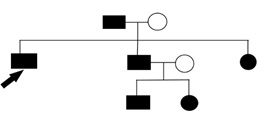A rare case report of Blepharophimosis syndrome associated with esotropia and nystagmus
Abstract
The authors report here a rare case of blepharophimosis syndrome which was associated with esotropia and nystagmus. Blepharophimosis syndrome is a clinical entity characterized by blepharophimosis, ptosis, epicanthus inversus, and telecanthus. In our case, it was also associated with horizontal nystagmus and esotropia. Our patient also had a bilateral mature cataract. It can either be type 1 or type 2 depending on the associated systemic manifestations. The present study describes a case of BPES type 2 with associated nystagmus and esotropia with a bilateral mature cataract.
Downloads
References
2. Sevel D. A reappraisal of the development of the eyelids. Eye (Lond) 1988;2(Pt 2):123-9.
3. Oley C, Baraister M. Blepharophimosis, ptosis, epicanthus inversus syndrome (BPES syndrome). J Med Genet 1988;25:47-51.
4. Vassalli A, Matzuk MM, Gadnr HAR, Lee KF, Jaenisch R. Activin/inhibin[beta]β subunit gene disruption leads to defects in eyelid development and female reproduction. Genes Dev 1994;8:414-27.
5. Maw M, Kar B, Biswas J, Biswas P,Nancarrow D, Bridges R, Kumaramanickavel G, Denton M, Badrinath SS. Linkage of blepharophimosis syndrome in a large Indian pedigree to chromosome 7p. Human Molecular Genetics 1996; 5(12)2049-54.
6. Verdin H, De Baere E. Blepharophimosis, Ptosis, and Epicanthus Inversus. 2004 Jul 8 [Updated 2015 Feb 5]. In: Adam MP, Ardinger HH, Pagon RA, et al., editors. GeneReviews® [Internet]. Seattle (WA): University of Washington, Seattle; 1993-2020. Available from: https://www.ncbi.nlm.nih.gov/books/NBK1441/.
7. Allen C, Rubin P. Blepharophimosisptosis- epicanthus inversus syndrome (BPES): clinical manifestation and treatment. Int Ophthalmol Clin 2008;48(2):15-23.
8. Oley C, Baraitser M. Blepharophimosis, ptosis, epicanthus inversus syndrome (BPES syndrome). J Med Genet 1988; 25: 47-51.
9. Beckingsale PS, Sullivan TJ, Wong VA, Oley C. Blepharophimosis: a recommendation for early surgery in patients with severe ptosis. Clin Experiment Ophthalmol. 2003;31:138–42.
10. Tang SJ, Wang XK, Wang YL, Lin LX, Sun Y. [The mutation study of the FOXL2 gene in a big Chinese family with blepharophimosis-ptosis-epicanthus inversus syndrome]. Zhonghua Zheng Xing Wai Ke Za Zhi 2007; 23:48-50. Chinese
11. Sa HS, Lee JH, Woo KI, Kim YD. A new method of medial epicanthoplasty for patients with blepharophimosis-ptosis-epicanthus inversus syndrome. Ophthalmology. 2012;119:2402–7.
12. Decock CE, Shah AD, Delaey C, Forsyth R, Bauters W, Kestelyn P, De Baere E, Claerhout I. Increased levator muscle function by supramaximal resection in patients with blepharophimosis-ptosis-epicanthus inversus syndrome. Arch Ophthalmol. 2011b;129:1018–22.
13. Wu SY, Ma L, Tsai YJ, Kuo JZ. One-stage correction for blepharophimosis syndrome. Eye (Lond). 2008;22:380–8.
14. Sebastiá R, Herzog Neto G, Fallico E, Lessa S, Solari HP, Ventura MP. A one-stage correction of the blepharophimosis syndrome using a standard combination of surgical techniques. Aesthetic Plast Surg. 2011;35:820–7.
15. Liu H, Shao Y, Zhao Z, Zhang D. One-stage correction of blepharophimosis-ptosis-epicanthus inversus syndrome using a frontalis muscle transfer technique. J Plast Surg Hand Surg. 2014;48:74–9.
16. Decock CE, Claerhout I, Leroy BP, Kesteleyn P, Shah AD, De Baere E. Correction of the lower eyelid malpositioning in the blepharophimosis-ptosis-epicanthus inversus syndrome. Ophthal Plast Reconstr Surg. 2011a;27:368–70.
17. Aginew, cited by Arruga, H. Ocular surgery, New York, 1952, McGraw Hill Book Co.
18. Aleksandra I, Andrzej Z, Edward L, Bogusław A, Tomasz Z. Evaluation of the Surgical Treatment for Congenital Blepharoptosis Using Mustarde’s Modified Method, Pol Przegl Chir. 2016 May 1;88(3):155-9.
19. Wendell L, Hughes. Surgical Treatment of Congenital Palpebral Phimosis. AMA Arch Ophthalmol. 1955;54(4):586-590.

Copyright (c) 2020 Author (s). Published by Siddharth Health Research and Social Welfare Society

This work is licensed under a Creative Commons Attribution 4.0 International License.


 OAI - Open Archives Initiative
OAI - Open Archives Initiative



















 Therapoid
Therapoid

